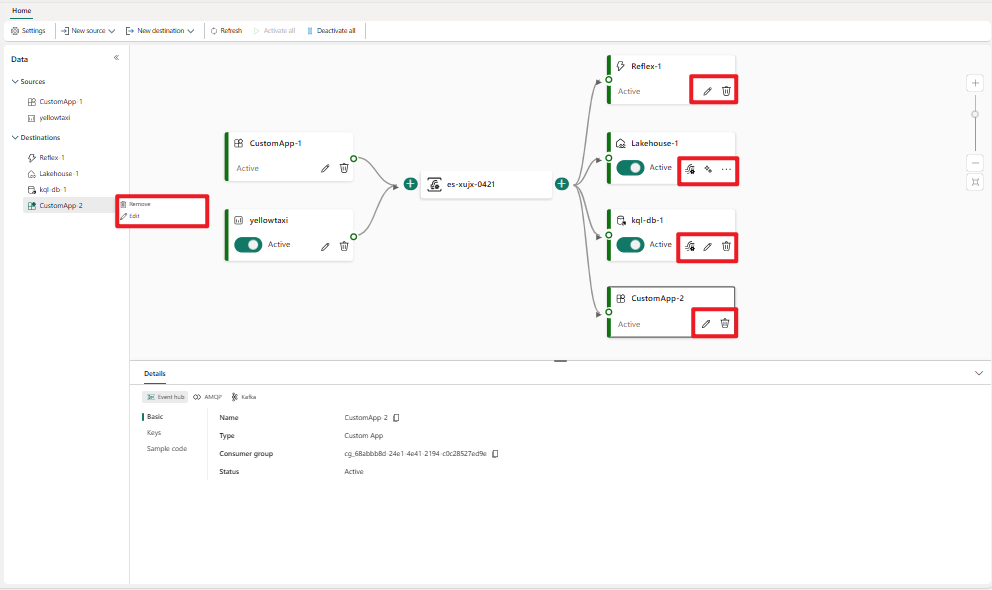Add and manage a destination in an eventstream
After you create an eventstream in Microsoft Fabric, you can route the data to different destinations. For a list of destinations that you can add to your eventstream, see Supported destinations.
Prerequisites
To add a destination to an eventstream, you need the following prerequisites:
- Access to the Fabric premium workspace where the eventstream is located with Contributor or higher permissions.
- For an Eventhouse, Lakehouse, or Reflex destination, access to the premium workspace where the destination is located with Contributor or higher permissions.
Supported destinations
Fabric event streams supports the following destinations. Use links in the table to navigate to articles about how to add specific destinations.
Note
If you want to use enhanced capabilities that are in preview, select Enhanced capabilities at the top. Otherwise, select Standard capabilities. For information about enhanced capabilities that are in preview, see Introduction to Fabric event streams.
| Destination | Description |
|---|---|
| Custom endpoint (i.e., Custom App in standard capability) | With this destination, you can easily route your real-time events to a custom endpoint. You can connect your own applications to the eventstream and consume the event data in real time. This destination is useful when you want to egress real-time data to an external system outside Microsoft Fabric. |
| Eventhouse | This destination lets you ingest your real-time event data into an Eventhouse, where you can use the powerful Kusto Query Language (KQL) to query and analyze the data. With the data in the Eventhouse, you can gain deeper insights into your event data and create rich reports and dashboards. You can choose between two ingestion modes: Direct ingestion and Event processing before ingestion. |
| Lakehouse | This destination gives you the ability to transform your real-time events before ingesting them into your lakehouse. Real-time events convert into Delta Lake format and then store in the designated lakehouse tables. This destination supports data warehousing scenarios. |
| Reflex | This destination lets you directly connect your real-time event data to a Reflex. Reflex is a type of intelligent agent that contains all the information necessary to connect to data, monitor for conditions, and act. When the data reaches certain thresholds or matches other patterns, Reflex automatically takes appropriate action such as alerting users or kicking off Power Automate workflows. |
| Derived stream | Derived stream is a specialized type of destination that you can create after adding stream operations, such as Filter or Manage Fields, to an eventstream. The derived stream represents the transformed default stream following stream processing. You can route the derived stream to multiple destinations in Fabric, and view the derived stream in the Real-Time hub. |
| Destination | Description |
|---|---|
| Custom app | With this destination, you can easily route your real-time events to a custom application. It allows you to connect your own applications to the eventstream and consume the event data in real time. It's useful when you want to egress real-time data to an external system living outside Microsoft Fabric. |
| KQL database | This destination enables you to ingest your real-time event data into a KQL database, where you can use the powerful Kusto Query Language (KQL) to query and analyze the data. With the data in the Kusto database, you can gain deeper insights into your event data and create rich reports and dashboards. You can choose between two ingestion modes: Direct ingestion and Event processing before ingestion. |
| Lakehouse | This destination provides you with the ability to transform your real-time events before ingesting events into your lakehouse. Real-time events convert into Delta Lake format and then stored in the designated lakehouse tables. It helps with your data warehousing scenario. To learn more about how to use the event processor for real-time data processing, see Process event data with event processor editor. |
| Reflex | This destination allows you to directly connect your real-time event data to a Reflex. Reflex is a type of intelligent agent that contains all the information necessary to connect to data, monitor for conditions, and act. When the data reaches certain thresholds or matches other patterns, Reflex automatically takes appropriate action such as alerting users or kicking off Power Automate workflows. |
Note
The maximum number of sources and destinations for one eventstream is 11.
Manage a destination
You can edit or remove an eventstream destination through either the navigation pane or the canvas.
When you select Edit, the edit pane opens in the right side of the main editor. You can modify the configuration as you wish, including the event transformation logic, through the event processor editor.
